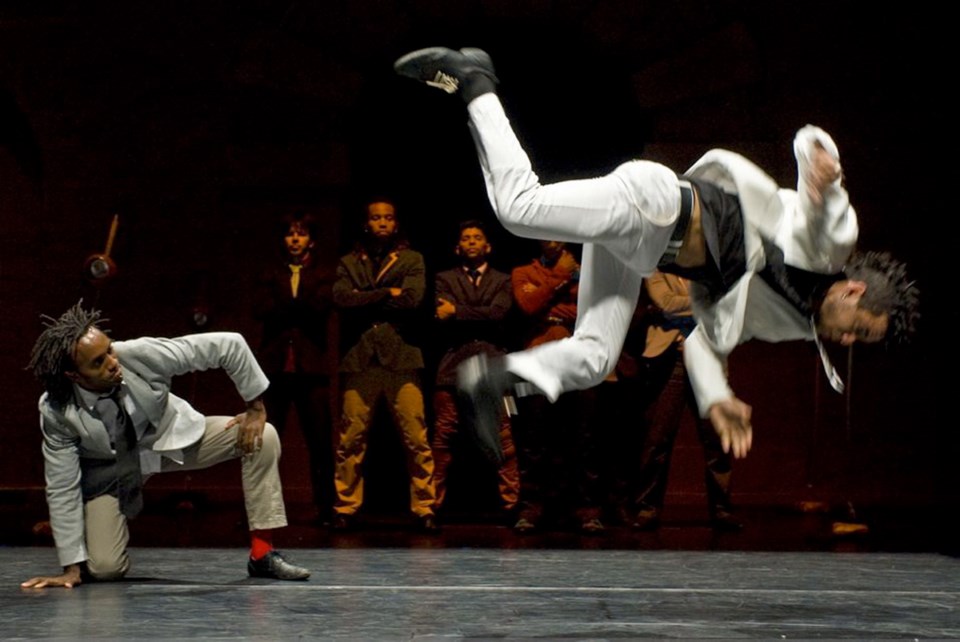REVIEW
Käfig Brasil
Where: Royal Theatre
When: March 13
Rating: 4 (out of five)
During Compagnie Käfig’s performance at the Royal Theatre, one of nine young male dancers ripped open his shirt.
The shirt opened so easily and quickly, it was surely fastened with Velcro. Certainly, there was no fumbling with buttons. At any rate, it triggered an immediate response from the woman beside me on Friday night.
“Ohhm,” she said. At least, it sounded like an “ohhm”.
This dancer possessed what in common parlance is known as a “six-pack”. Just then, a second dancer tore open his shirt. There was a noticeable ripple in the audience — a collective gasp of appreciation for the well-toned male physique.
“I hope you’re getting all of this down,” said the woman beside me (the same one who had said “ohhm”).
“Oh yes,” I said. “I certainly am.”
Compagnie Käfig is the creation of French choreographer Mourad Merzouki, a hip-hop enthusiast who appeared at curtain call following his troupe’s 60-minute performance. This particular piece, Käfig Brazil, is performed by Brazilian dancers originally from Rio’s favela (slum) district. The work blends hip-hop with capoeira, a dance-like Brazilian martial art that includes circus-style acrobatics.
Choreographed by Merzouki and collaborators, Käfig Brazil is set to a diverse score — mostly rhythmic electro-pop. “Käfig” means “cage” in German and Arabic, so fittingly, Käfig Brazil commenced with dancers seen in silhouette within a cage-like box.
The dancers wore street clothes, mostly short-sleeve shirts with ties. The uniformity of these costumes, in tandem with jaw-dropping exuberance of the movement, suggested a vital life force (common to all of humanity) being released in a most dramatic fashion.
Spontaneous cheers erupted when dancers — some of them sporting fashionable, pine-apple-shaped haircuts — flipped head-over-heels across the stage. Other sections suggested b-boy battles, with rubber-limbed, joint-snapping soloists trying to top one another
If one looked, there were trace elements of satire. In one sequence the dancers lined diagonally across the stage, unmoving, as though queuing for a bus. One would then touch another, sparking in chain reaction a short frenzy of heretofore-suppressed movement. Yet overall Käfig Brazil was not about social commentary or deep themes, but rather, the sheer joy of dance.
On paper, as some commentators have observed, there seems to be a “coals to Newcastle” element to a French dance company bringing hip-hop to North America. In practice the notion is pedantic. The dancing Käfig Brazil is a global hybrid of styles, as much contemporary dance as hip-hop.
The lighting, by Yoann Tivoli, is simple yet effective. Footlights illuminated the performers dramatically from ground level. A visual image that lingers is that of a sole dancer (with a beard and an Afro) lit from the front so a giant shadow was projected on the backdrop.
Above all, dancegoers were left impressed by the troupe’s ecstatic vitality. Typically, in mid-performance, the dancers clustered in a tight group, at first barely moving, then exuding a strange suppressed energy as they pulled apart like a exploding molecules.
A sense of good-natured humour was another through-line. At the night’s end, Compagnie Käfig turned their backs to us. Then Merzouki took a photograph of his grinning, now bare-chested dancers with we the audience — standing up and cheering — in the background.
